Under the Northern Lights: Discover Indigenous Captivating Cultures and Traditions of the Arctic
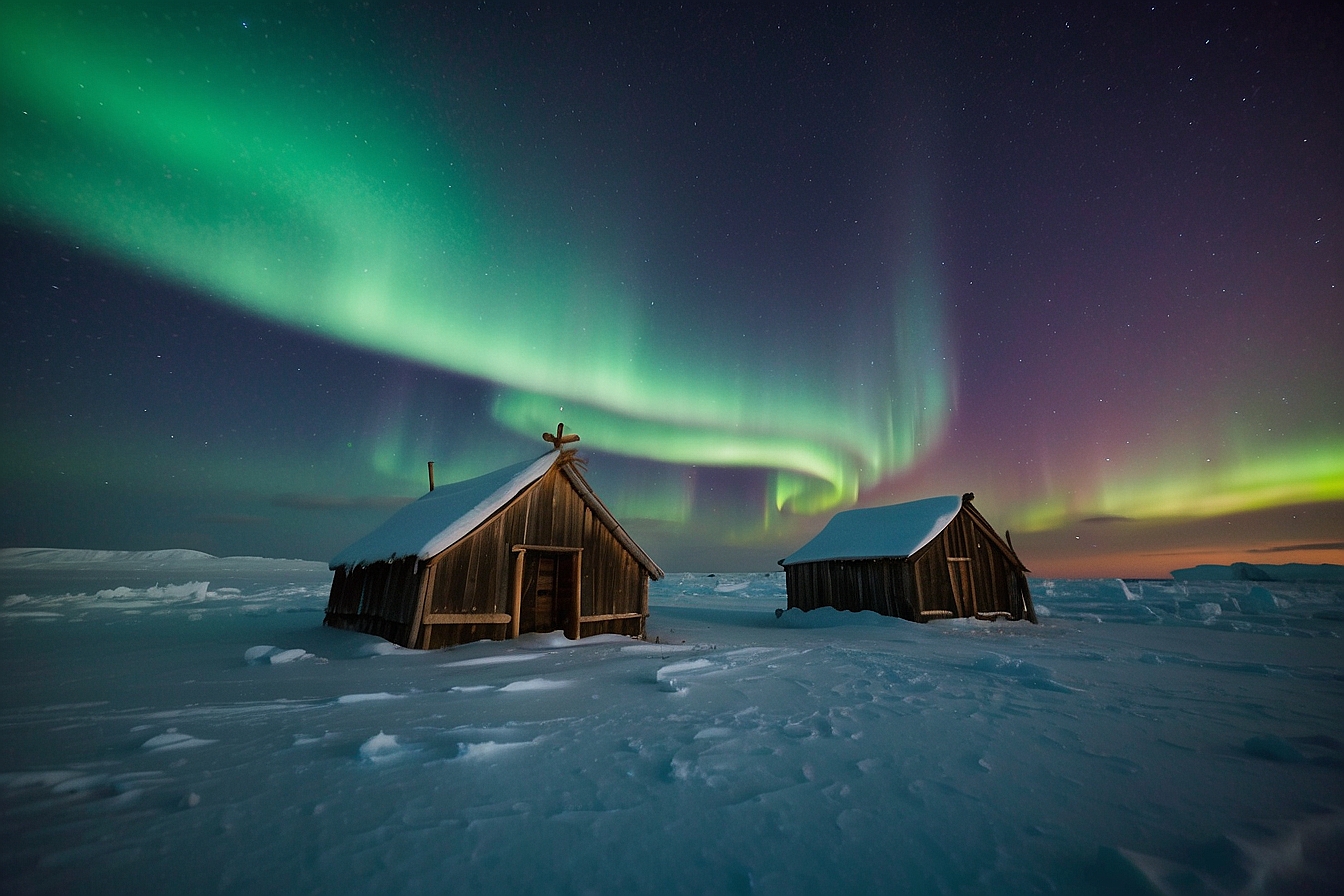
Updated On: April 26, 2024 by Fatma Mohamed
Bathed in the ethereal glow of the aurora borealis, or Northern Lights, the Arctic region is home to a tapestry of indigenous cultures, each with its own rich heritage and deep connection to the land. As we look to the skies where vibrant colours dance across the polar night, it’s important to remember that the ground beneath is just as alive with ancient stories and wisdom. The indigenous peoples of this region have nurtured and preserved their customs for generations, displaying resilience and ingenuity in one of the planet’s most challenging environments.
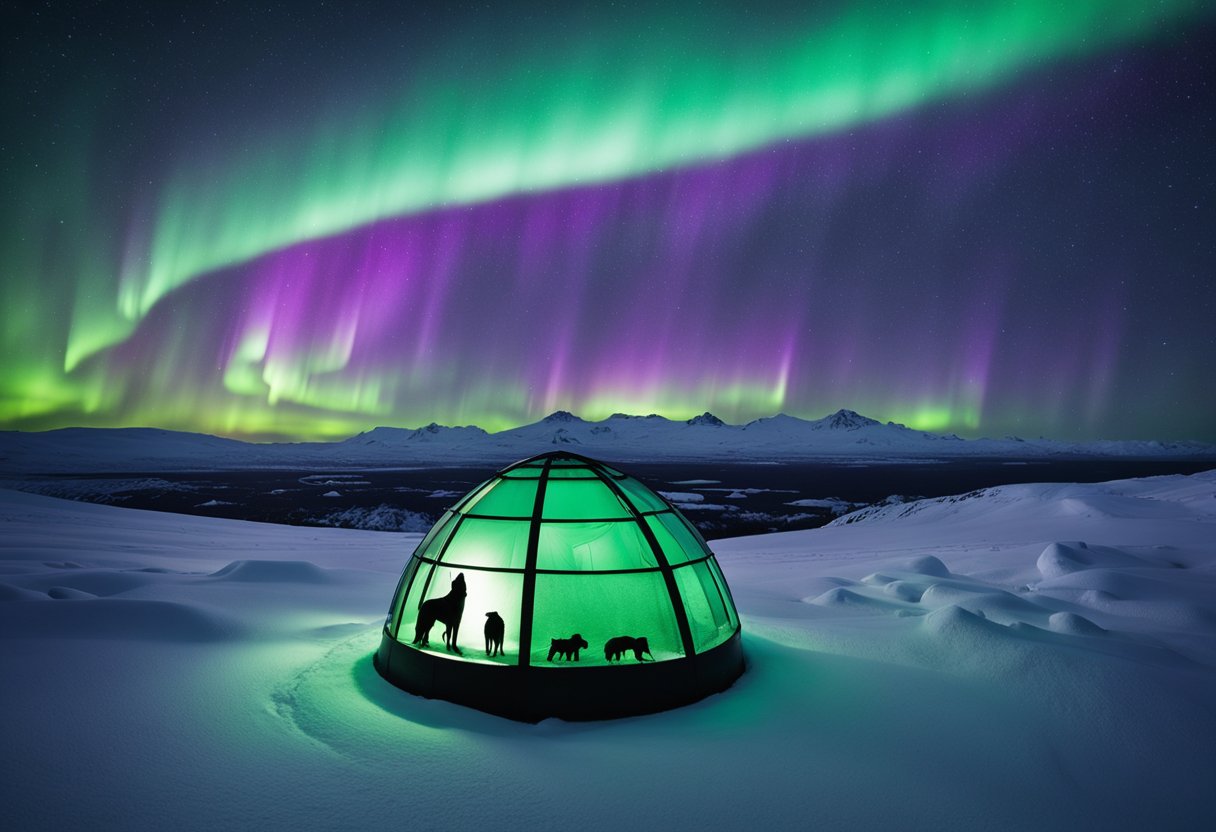
Their profound relationship with the environment is evident in every aspect of indigenous life, from the spiritual beliefs that intertwine with the natural world to the seasonal rhythms dictating festivals and daily activities. Amidst the shifting ice and the harsh climate, traditional ways of living not only persist but also evolve as these communities continue to adapt to contemporary issues while still holding onto their identities. The Northern Lights, a stunning natural phenomenon, have long held significant meaning in indigenous mythology, symbolising everything from the dance of ancestral spirits to omens and tales of celestial origins.
Table of Contents
Indigenous Peoples of the Arctic
The Arctic is a region steeped in the rich traditions and adaptable lifestyles of its indigenous population. With unique cultures that have developed over centuries, the Indigenous Peoples of the Arctic are a testament to human resilience and diversity.
The Inuit Culture
The Inuit—a group encompassing the native peoples of Greenland, Canada, and Alaska—have a culture deeply connected to the ice, ocean, and tundra of their environment. Language plays a vital role, with Inuit dialects varying across regions yet linked through the Eskimo-Aleut language family. Traditionally, Inuit designed highly efficient tools, attire, and shelters, such as the iconic igloo, all critical for survival in the harsh Arctic conditions. Inuit communities rely on subsistence hunting of sea mammals and have a rich tradition of oral storytelling, which passes down knowledge and traditions across generations.
The Sami Lifestyle
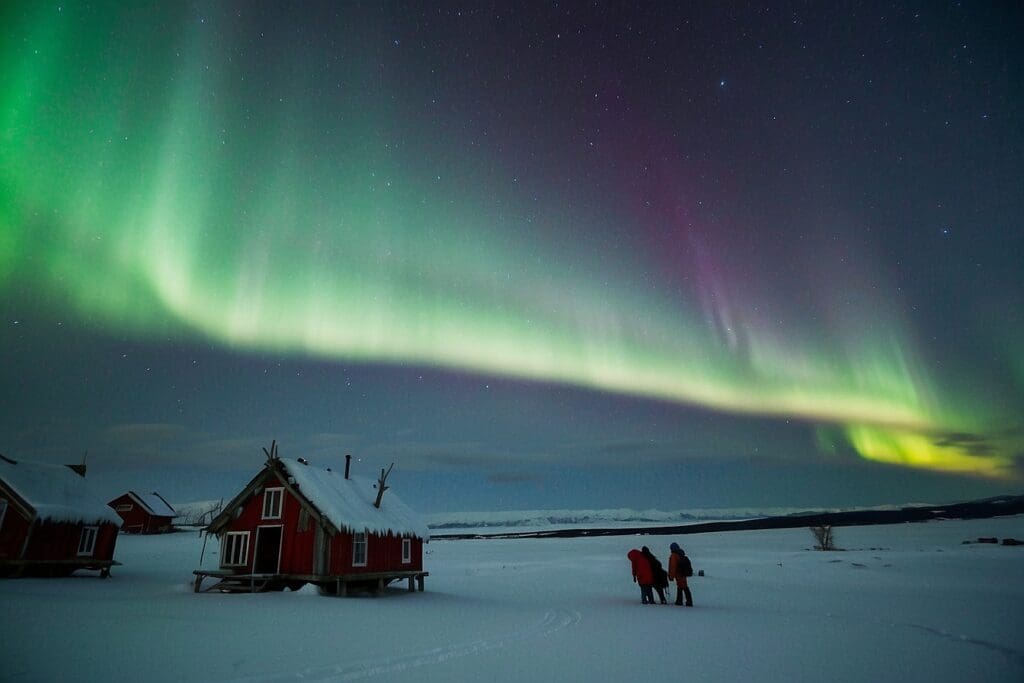
In contrast, the Sámi people, spanning across northern parts of Norway, Sweden, Finland, and the Kola Peninsula of Russia, are known for their distinct lifestyle, often centred around the practice of reindeer herding. Culture and sustainability are intertwined in Sámi society. Their traditional clothing, called gákti, is both practical and symbolic, often adorned with intricate patterns that signify the wearer’s family and marital status. The Sámi also possess a unique language group consisting of several languages and dialects that reflect their regional diversities.
First Nations of North America
Moving to the First Nations of North America, these diverse groups inhabit both the Arctic and sub-Arctic regions of Canada and the United States. The Arctic First Nations include the Gwich’in and the Inuvialuit, to name a few, who have adapted to life in vast areas of tundra and taiga. First Nations place a strong emphasis on community and interconnectedness with the natural world, valuing the land as a provider of both sustenance and spiritual guidance. Traditional skills like fishing, hunting, and crafting clothes from animal skins are highly revered, serving as a bridge between past and present.
Each indigenous group within the Arctic contributes to the multidimensional tapestry of human culture. Their deeply ingrained knowledge of the environment, detailed in their varied languages and practices, offers invaluable insights into sustainable living and the stewardship of natural resources. Despite the challenges posed by a changing climate and modern societal pressures, these communities continue to thrive, upholding traditions that echo through the ages.
The Northern Lights in Indigenous Mythology
The Northern Lights, or Aurora Borealis, hold profound significance in the mythologies of various Indigenous groups, who attribute spiritual meanings to these ethereal lights dancing across the Arctic skies.
Aurora in Inuit Mythology
In the theology of the Inuit, the Aurora is often seen as the spirits of the dead playing with a walrus head or ball. This concept connects the physical with the spiritual, with some belief they could communicate with their ancestors through these lights. For example, the Inuit of Kluane National Park have their unique interpretations and tales surrounding the Aurora Borealis.
Sami Legends and the Northern Lights
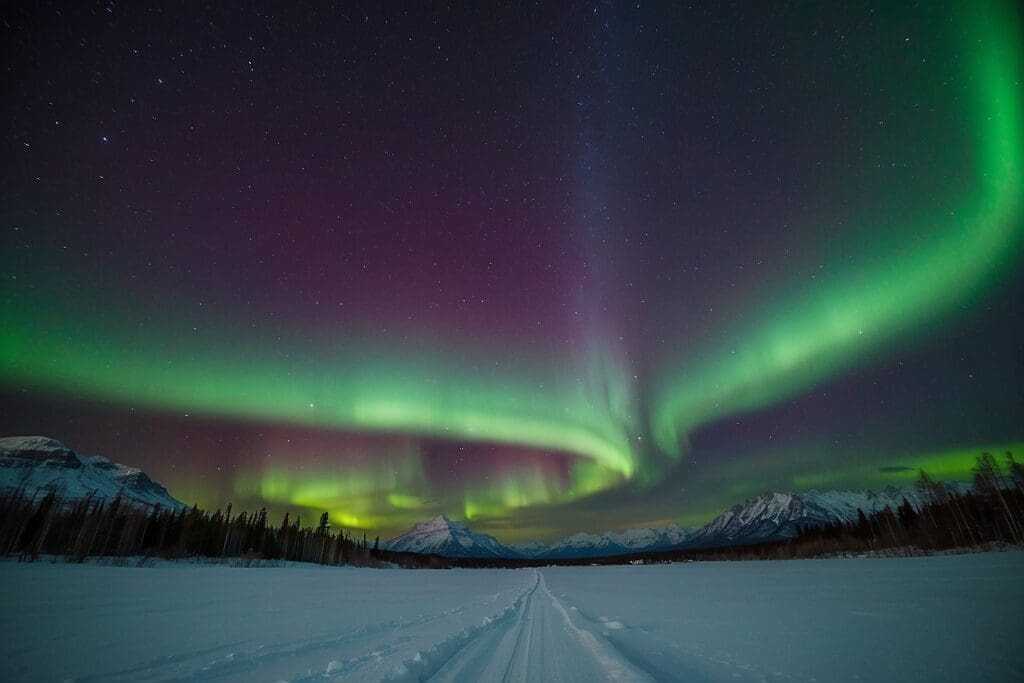
The Sami people, indigenous to northern Scandinavia, traditionally feared and respected the lights, seeing them as omens or messages from the spirits. They have their term for the aurora: “Guovssahas”, which means “the light which can be heard”, suggesting the Sami also believed the Northern Lights produced a mystical sound. As stated, due to the lights’ regularity in their region, they have an intricate part in Sami folklore.
Norse and Algonquin Beliefs
The Norse people, particularly the Vikings, interpreted the lights as reflections from the armour of the Valkyries, warrior women leading fallen soldiers to Valhalla. This connection with Norse gods and the valorisation of warriors show the importance of lights in their lore. On the other hand, the Algonquin people believed that the lights were created by the fire of Nanabozho, their creator spirit, near the earth’s surface, representing the spirits of their ancestors, particularly spirits of the dead who dwell in the sky.
Traditional Ways of Living
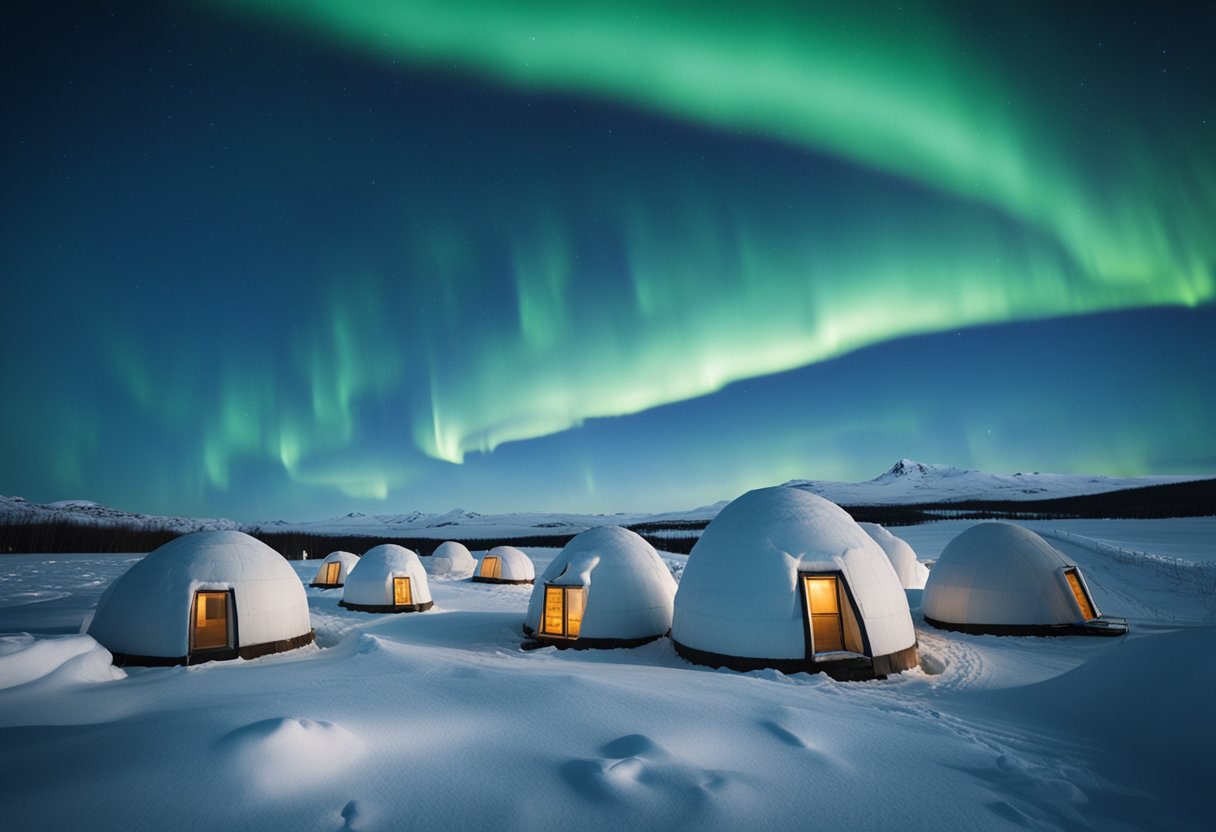
As we explore the indigenous Arctic cultures, it is important to note their deep connection with nature. The traditional ways of living are primarily centred around fishing, hunting, reindeer herding, and the creation of crafts and clothing, which have been passed down through generations.
Fishing and Hunting
Fishing and hunting are fundamental to survival in the harsh Arctic climate. Communities rely on the abundance of the ocean and tundra, where fish, notably including species like Arctic char and salmon, provide a staple food source. The practice of whale and walrus hunting remains vital, not only for food but also for other materials derived from these animals.
- Whales: Utilised for their meat and blubber.
- Seals: Their skin is used for waterproof clothing.
- Walrus: Apart from meat, their tusks and bones are used in tools and art.
Reindeer Herding
Reindeer herding, a lifestyle we have come to associate with the Sámi people, has a significant role in Arctic indigenous cultures. The reindeer provide meat, hide for clothing, and are integral to transportation across the snowy landscape.
- Reindeer: Essential for meat, clothing, and transportation.
Crafts and Clothing
Traditional crafts and clothing among indigenous Arctic communities reflect a harmonious blend of practicality and artistic expression. Clothing is often made from the hides of caribou and seals and designed to withstand the extreme cold.
- Clothing: Consists of intricately designed garments, often adorned with beads or embroidery.
- Crafts: Include items such as hand-carved tools and decorative items from animal bones and tusks.
These activities not only offer sustenance and shelter but also help to maintain a cultural identity that has thrived for thousands of years under the northern lights.
Environmental Wisdom and Adaptations
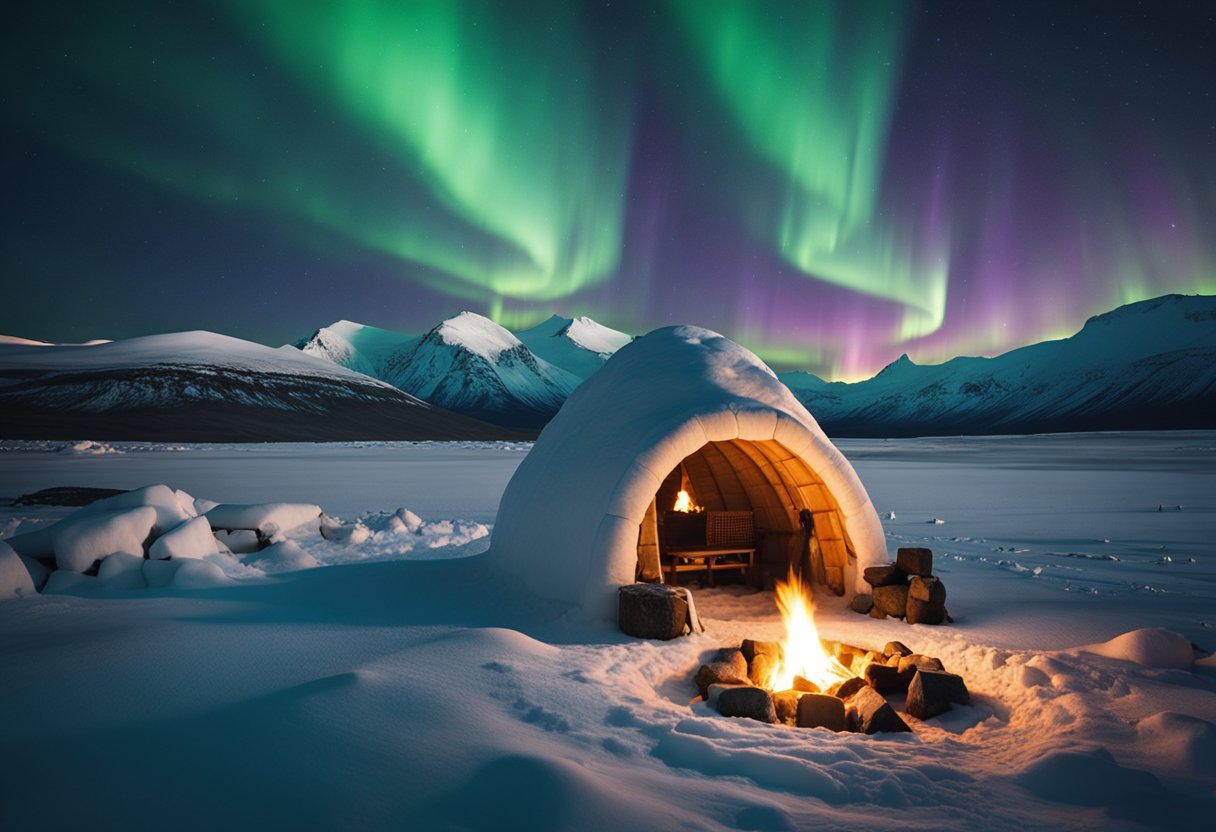
In the Arctic, Indigenous people have developed profound knowledge systems and life-sustaining practices in response to their surroundings. We’ll explore how the tundra ecosystems and climate adaptations are central to their survival and cultural identity.
Tundra Ecosystems
The tundra is a vast, treeless landscape where subsoil is permanently frozen. Indigenous cultures have a thorough understanding of this environment’s rhythms and resources. For example, the Arctic fox, a key species in the tundra, is well adapted to the cold and its fur changes colour with the seasons, which Indigenous peoples observed to predict weather patterns and hunting success.
Climate Adaptations
In the face of climate change, these societies demonstrate remarkable adaptations. They’ve built homes to withstand extreme weather and developed clothing from animal skins that provide insulation against the frigid temperatures. Through their harmonious relationship with nature, Indigenous Arctic cultures continue as stewards of the environment, living demonstrations of science in action as they use empirical knowledge to cope with an increasingly variable climate.
Seasonal Rhythms and Festivities
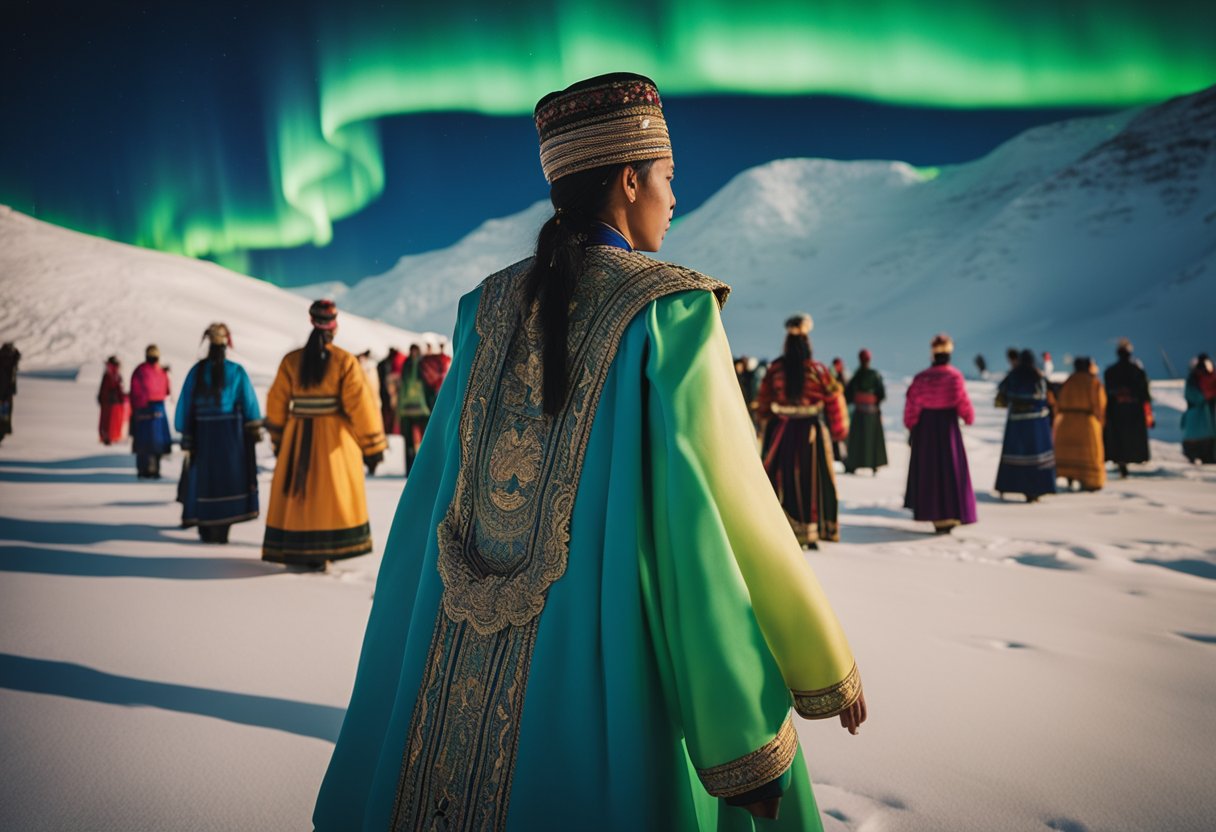
In the Arctic, the lives of Indigenous peoples are intertwined with the cadence of the seasons. From the mystical displays of the Northern Lights to the bounty of the fall, each season brings its festivities and traditions.
Winter and the Aurora
Winter in the Arctic is a time of profound beauty, underscored by the ethereal dance of the Northern Lights. Indigenous cultures often interpret the Aurora Borealis as a spiritual phenomenon, with various legends explaining its existence. One such belief is the Finnish myth of fire foxes, which considers the Northern Lights as sparks from the foxes’ tails striking the snowy landscape. These vivid winter skies are not just aesthetic wonders—they enrich our cultural storytelling and inspire traditional celebrations.
Fall Harvests and Traditions
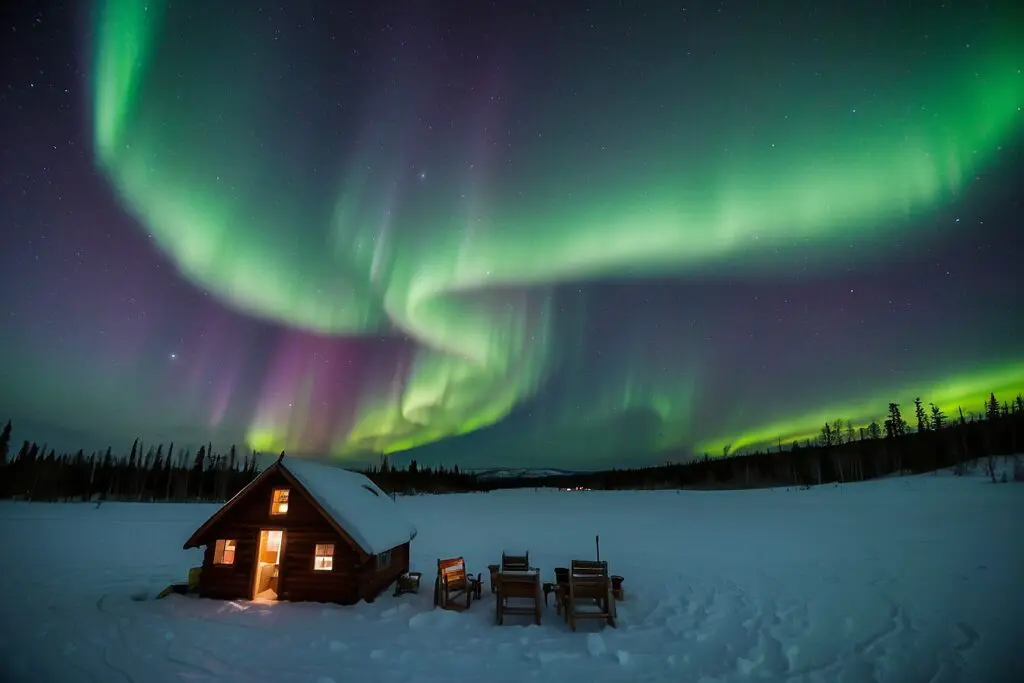
As the cold retreats, fall marks a period of abundance and preparation. Communities engage in fall harvests, gathering food that will sustain them through the harsh winter months. It’s also a time for celebration; traditions come to the forefront, with storytelling and the passing down of knowledge integral to these practices. Fall festivities are intimately connected with gratitude for the season’s yield and recognition of the cycles that dictate the harsh, beautiful Arctic environment.
Contemporary Indigenous Issues
In addressing contemporary Indigenous issues, we must recognise the pressing challenges that Indigenous peoples face in areas like North America and Europe. This includes those living in regions under the Northern Lights, such as Greenland and Northern Canada.
Land Rights and Sovereignty
For Indigenous peoples, land is more than a resource—it’s a source of identity, heritage and livelihood. However, land rights and sovereignty remain contentious. In North America, Indigenous communities continue to advocate for the recognition of their ancestral lands and the right to self-governance. This struggle is a crucial point of tension as they seek to preserve their way of life against external interests.
Cultural Revitalisation
Cultural revitalisation is pivotal in keeping Indigenous cultures thriving. Across Europe and North America, efforts are underway to revive languages, traditions, and practices that have been suppressed or lost over time. With initiatives that emphasise the importance of cultural identity, Indigenous communities are working towards strengthening their cultures for future generations.
Climate Change Impact
The impact of climate change is indisputable, particularly for communities in the Arctic. Indigenous peoples in regions like Northern Canada are witnessing the direct effects on their environment and way of life. Traditional knowledge is instrumental in adaptation strategies, yet these communities are often at the forefront, experiencing the consequences of changing weather patterns and ecosystems.
Spiritual Beliefs and Practices
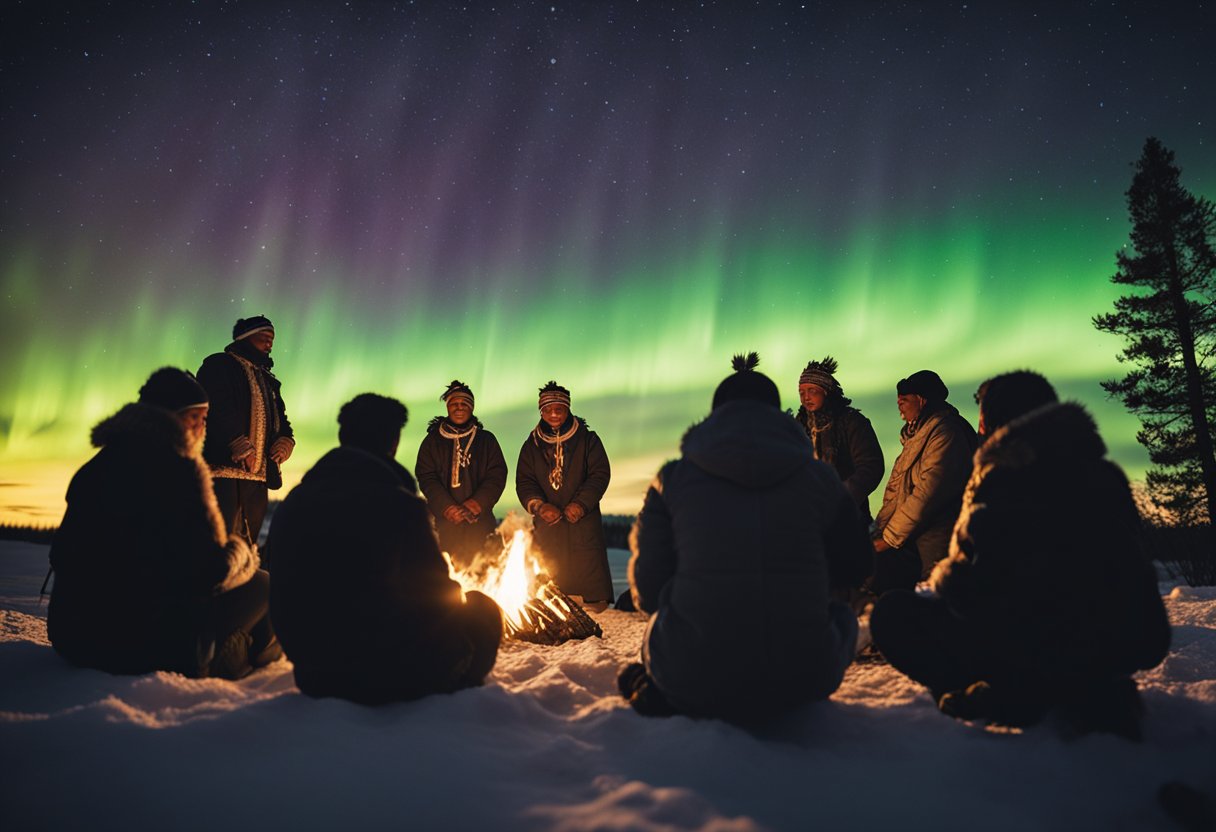
In the vivid tapestry of Arctic Indigenous cultures, spiritual beliefs and practices are deeply woven, centring on a profound respect for the land and its inhabitants—visible and invisible. Our ancestors, mythology, and the spirits they honoured shape a world where humans, nature, and the supernatural coexist in a delicate balance.
Shamanism
Shamanism stands as a cornerstone of spiritual practice among Arctic Indigenous peoples. It is within this role that individuals—believed to communicate with the spirit world—guide and heal their communities. The shaman traverses the boundaries of our world and the realms beyond, often entering trance states to engage with spirits, seeking insight and intervention.
Creation Stories
Our Creation Stories recount the birth of the world from a rich oral tradition, where gods and spirits played integral roles in shaping the land and sea. In these narratives, entities like Odin and other mythological figures from the Norse pantheon might intertwine with local mythos, underscoring a landscape where every element holds significance.
Afterlife Concepts
Concepts of the Afterlife among our peoples vary, with beliefs in places akin to Valhalla, where the spirits of the dead gather. Others speak of returning to the land, joining ancestors who watch over the living. Across these beliefs, there’s a mutual understanding of life as a cyclical journey, honouring those who have passed into the spirit realm.
Our practices and stories stand as a testament to the richness of our heritage, reflecting our enduring connection to the Arctic and its supernatural inhabitants.
Interaction with Wildlife
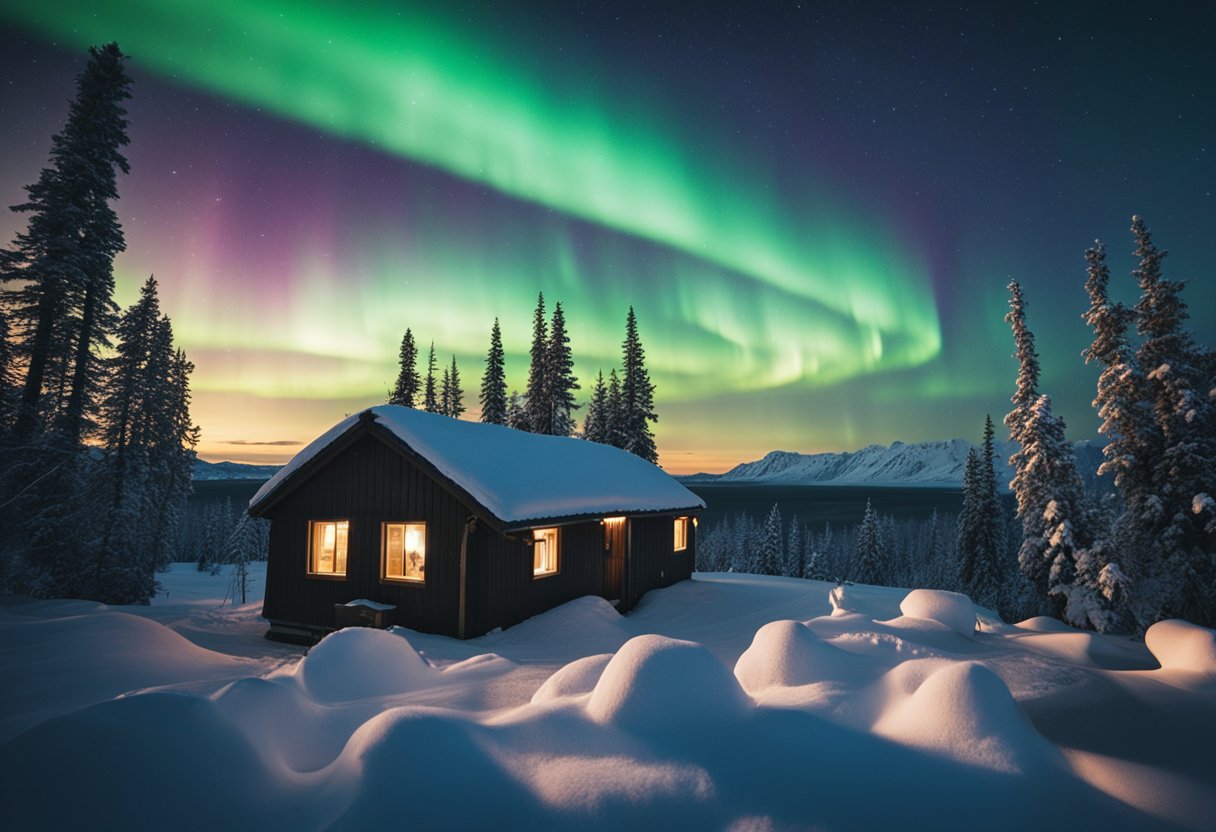
In the Arctic, indigenous communities maintain a profound connection with the natural world, especially its fauna. The wildlife here not only forms an integral part of the ecosystem but also underpins many aspects of traditional lifestyles, from diet to cultural practices.
Marine Life
In the cold Arctic waters, marine mammals such as whales, walruses, and seals play a critical role in our subsistence and culture. We respect these creatures and understand their vital place in our history. For instance, walruses are not only a source of food but also provide tusks for making tools and walrus skulls for ceremonial uses. Our methods of hunting are sustainable, ensuring that future generations can continue to reap the benefits of the rich marine life.
Terrestrial Animals
Moving away from the icy seas to the tundra, the terrestrial animals of the Arctic are key to balancing our way of life. We engage in trapping various species like the Arctic fox, which provides both fur for warmth and meat. Our systematic approach to trapping relies on age-old wisdom passed down through bands or family groups, ensuring we affect the local populations minimally. Our deep understanding of the land and animal behaviour ensures a responsible interaction with the wildlife around us.
Scientific Exploration of the Aurora
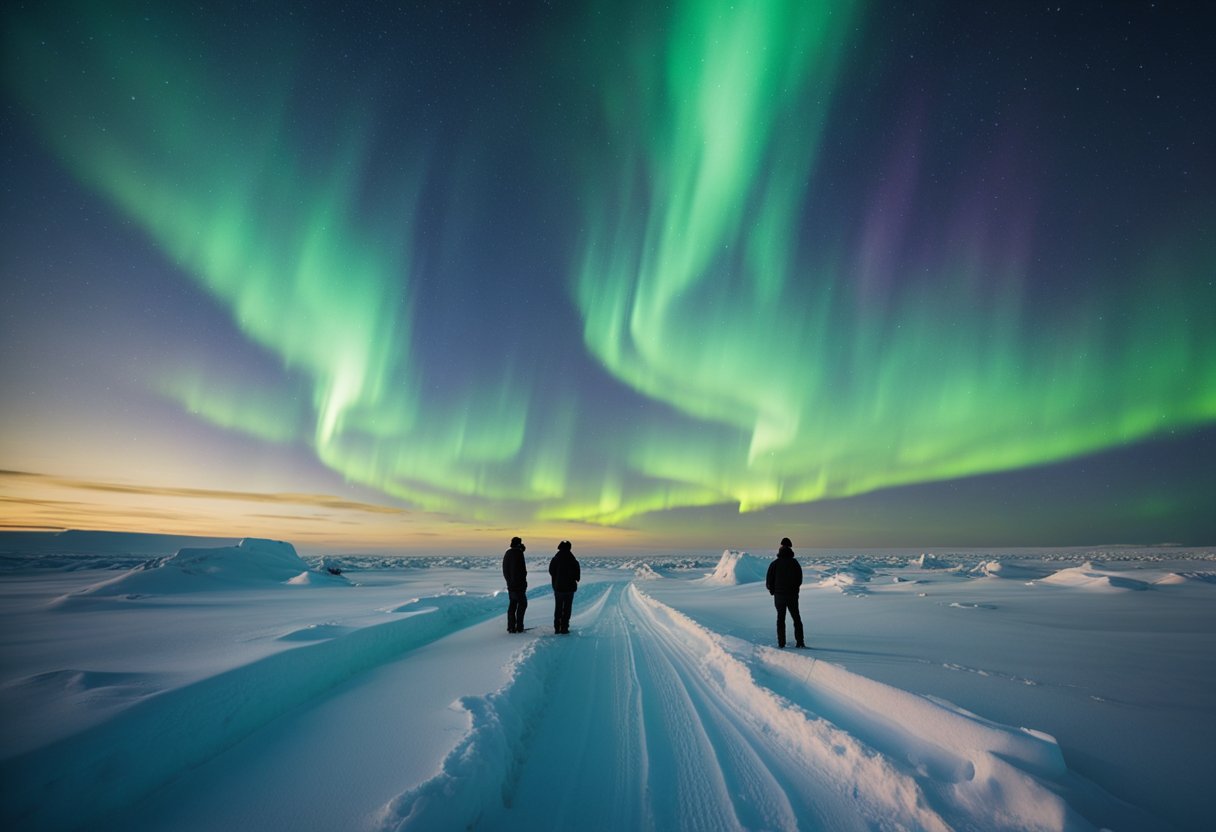
In the scientific community, the marvel of the aurora, or northern lights, is attributed to the intricate dance of electrically charged particles originating from the sun.
Atmospheric Phenomena
The aurora is a spectacular natural light display predominantly seen in high-latitude regions around the Arctic. It is an atmospheric phenomenon occurring high above the Earth’s surface, as charged particles from the solar wind collide with gases like nitrogen and oxygen in our atmosphere. These collisions produce the vivid colours typically associated with the aurora; oxygen is responsible for the green and red hues, while nitrogen contributes blue and purple tones.
Aurora Through the Lens of Science
We understand that these electrically charged particles are guided by the Earth’s magnetic field towards the poles, which is why the northern lights are primarily viewed in the polar regions. Our studies in the field of science have determined that the intensity and frequency of auroral displays are influenced by the activity of the sun, with solar maximums bringing about more frequent and vivid displays. Knowing the behaviour of the sun’s cycles allows us to predict with some accuracy when the aurora will be most visible.
Artistic Representations and Folk Arts
In our exploration of Arctic Indigenous cultures, we discover a treasure trove of artistic expression deeply interwoven with myths and legends. Among these, music and performance, alongside visual arts and crafts, stand out as vibrant testaments to the rich cultural traditions.
Music and Performance
Our musical journey through the Arctic reveals a soundscape where traditional melodies are often tied to the community’s narratives and ceremonies. Throat singing, a distinct form of vocal performance among some cultures like the Inuit, showcases a mesmerising duet where performers imitate natural sounds. This unique musical style resonates with the mythological tapestry of the Arctic, capturing its natural spirit and cultural essence. Performances using drums made from animal skins are central, providing a driving force that underscores communal dances and storytelling sessions that often recount ancient legends.
Visual Arts and Crafts
Turning to the visual arts, we see intricate crafts that illuminate the artistic skills handed down through generations. Items such as clothing, beadwork, and carvings not only serve practical purposes but also convey stories and beliefs. Within these crafts, one can discern symbols from traditional myths, such as the “fire foxes” phenomenon, known in Finland as revontulet. These handicrafts, ranging from tufting to intricate jewellery, often bear the vibrant colours and shapes seen in the Northern Lights, bridging the connection between celestial dance and material art forms.
The Arctic in Global Context
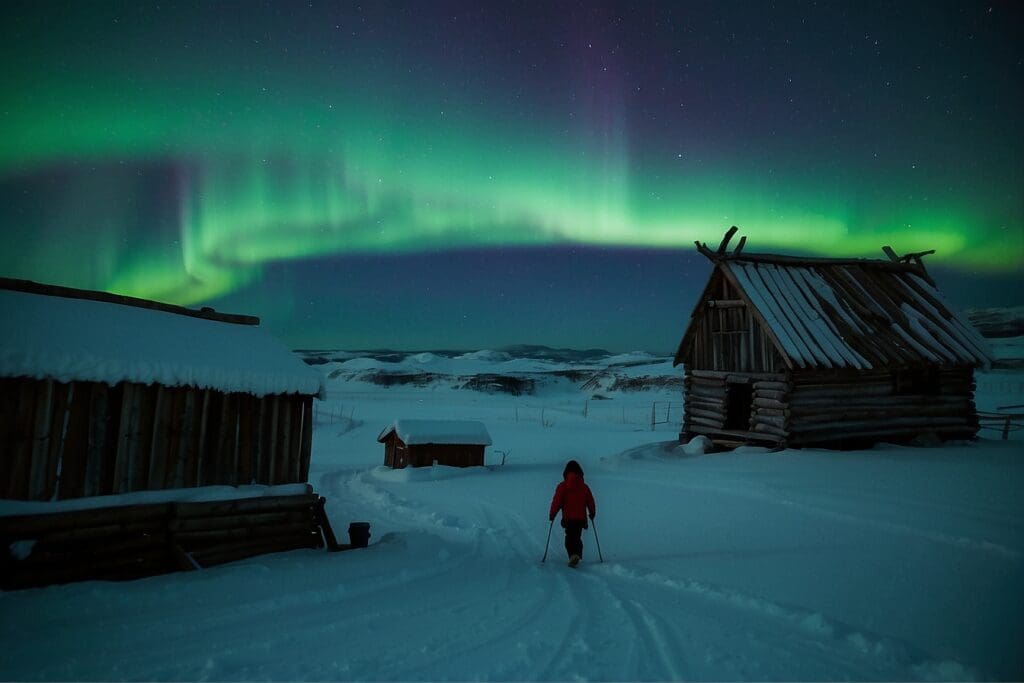
The Arctic plays a vital role in international cooperation and cultural exchange, serving as a nexus for Indigenous communities and the world.
International Indigenous Networks
The Arctic region, a circumpolar zone that encompasses parts of Finland, Iceland, Sweden, Norway, Denmark, and Northern Scandinavia, is not just a frontier of ice and snow; it has become a platform for global dialogue and networking among Indigenous tribes. These networks reinforce the cultural sovereignty of local communities, showing a united front in international policy discussions. Groups such as the Inuit Circumpolar Council unite voices from different Arctic nations to address common issues and offer a collective narrative on topics ranging from climate change to cultural preservation.
Tourism and Cultural Exchange
Tourism serves as a conduit for cultural exchange, introducing people from around the globe to the richness of Arctic life under the Northern Lights. Countries within the Arctic circle, like Sweden and Norway, attract visitors eager to experience the distinctive traditions and lifestyles of Indigenous cultures and to witness the pristine environments that have supported these communities for millennia.
We see this manifest in the UK travellers seeking the remote tranquillity of Scandinavian landscapes, bringing along a desire to learn and exchange cultural values. Simultaneously, tourism helps to bolster local economies and provides opportunities for Indigenous art and handicrafts to gain international acclaim, though it must be managed to ensure the sustainability of these fragile ecosystems and the longevity of traditional cultures.
Frequently Asked Questions
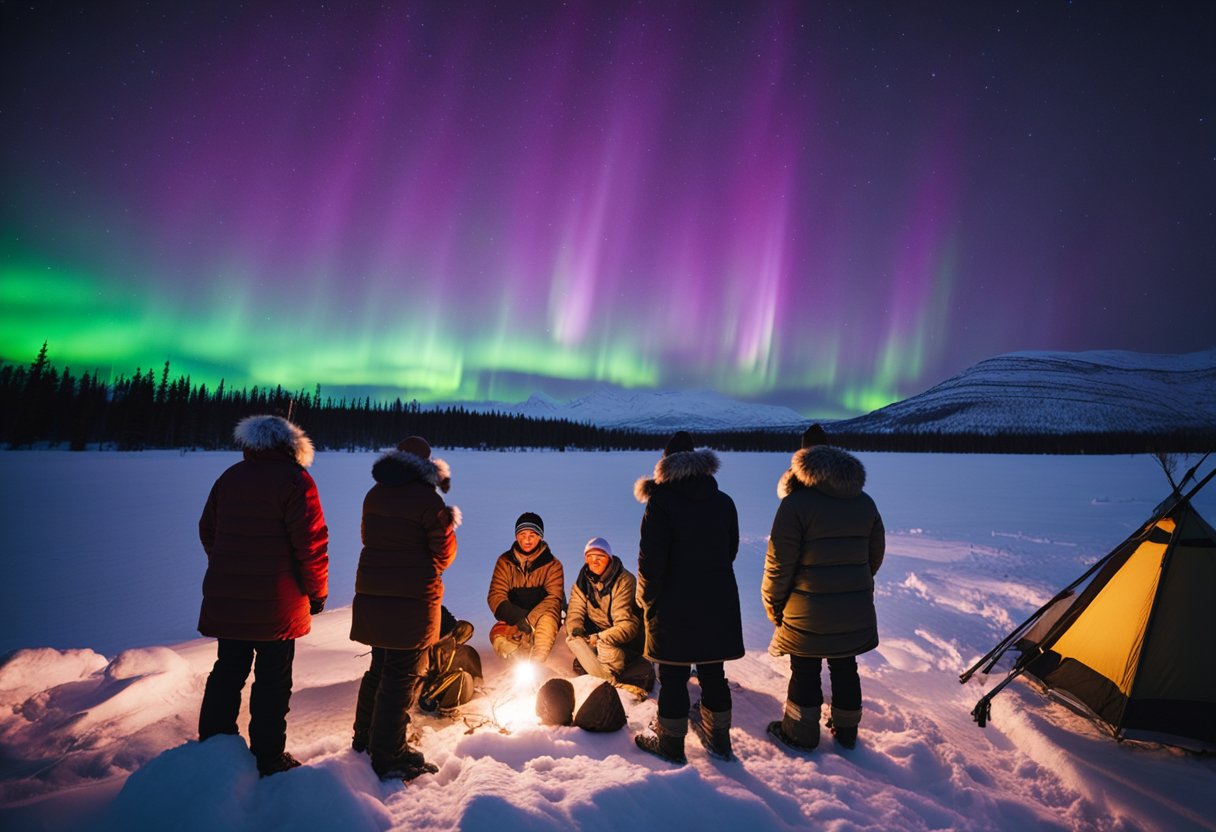
In this section, we address common curiosities regarding the cultural and spiritual significance of the Northern Lights, also known as the Aurora Borealis, within various Arctic Indigenous cultures.
What cultural significance do the Northern Lights hold for Arctic Indigenous peoples?
For many Arctic Indigenous peoples, the Northern Lights are not just a natural phenomenon but a canvas where the stories and teachings of their ancestors are painted in the sky. These lights serve as a bridge between the physical and spiritual worlds, offering a visual connection to past generations and the land itself.
How have Northern Lights myths and legends shaped the beliefs of Native American tribes?
Myths and legends about the Northern Lights have been instrumental in shaping the worldviews and cultures of Native American tribes. With stories often perceiving the auroras as the dancing spirits of loved ones or an omen of war, these celestial events influence beliefs and customs across tribes from North Dakota to Alaska.
What do various Indigenous stories tell us about the creation of the Aurora Borealis?
Indigenous stories about the Aurora Borealis vary widely, yet they share a common thread of attributing the lights to extraordinary causes. For instance, some myths suggest that the lights come from ancestors’ torches as they guide hunters, while others believe they are the outcomes of celestial battles.
In what ways are the Northern Lights interpreted spiritually by different Indigenous cultures?
Different Indigenous cultures interpret the Northern Lights through a spiritual lens, viewing them as manifestations of their gods’ actions or messages. These interpretations are deeply embedded in their respective mythologies, reflecting a reverence for nature and spirituality that cycles with the seasons.
How is the Aurora Borealis connected to Inuit mythology and belief systems?
In Inuit mythology, the Aurora Borealis is closely connected to the tales of the afterlife, where the spirits play games with a walrus skull ball. The glow of the auroras reflects these playful encounters, symbolising the joy and continuity of life beyond death.
What figures or spirits are said to reside in the Northern Lights according to Indigenous folklore?
According to Indigenous folklore, various figures and spirits are said to reside in the Northern Lights. In some traditions, the lights are home to sky-dwellers, often depicted as either benevolent guardians who watch over the people or, more ominously, as harbingers of famine and strife.






